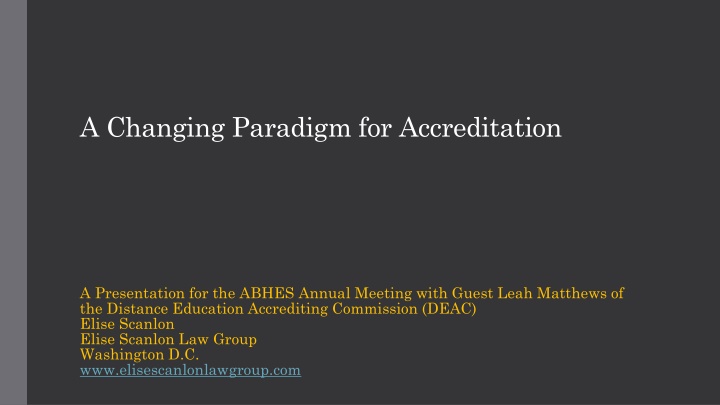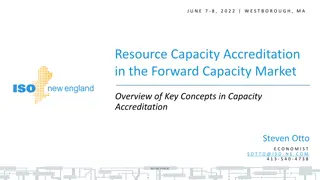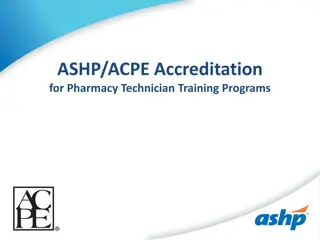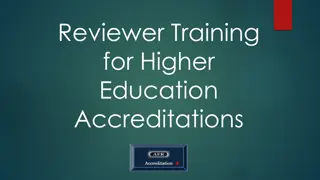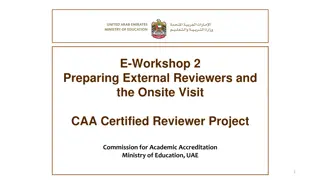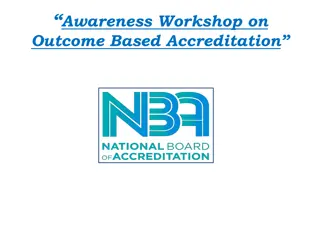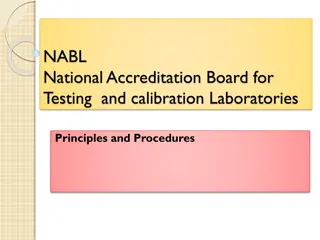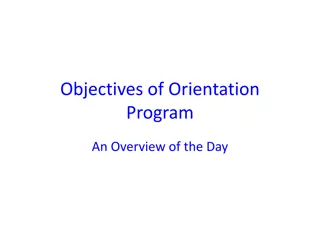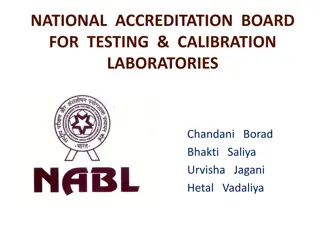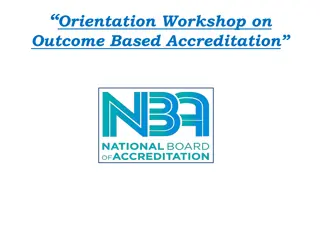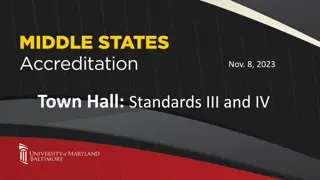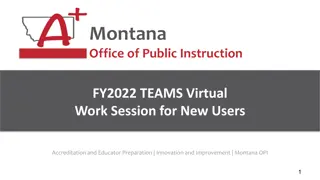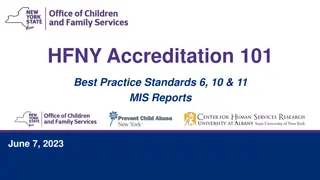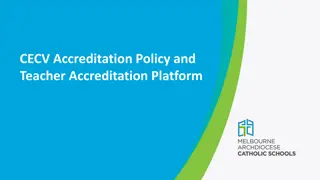Changing Paradigm in Accreditation: Legislative Landscape and Recommendations
This presentation discusses the evolving paradigm in accreditation within the education sector, focusing on legislative updates, including the introduction of bills, hearings, and the shifting responsibilities of accrediting bodies. It also highlights the recommendations put forth by the HELP Task Force for simplification of federal regulations, transparency, and accountability in accreditation processes. The Senate HELP Committee hearing further delves into topics like state authorization rules and the transferability of credits in higher education.
Download Presentation

Please find below an Image/Link to download the presentation.
The content on the website is provided AS IS for your information and personal use only. It may not be sold, licensed, or shared on other websites without obtaining consent from the author.If you encounter any issues during the download, it is possible that the publisher has removed the file from their server.
You are allowed to download the files provided on this website for personal or commercial use, subject to the condition that they are used lawfully. All files are the property of their respective owners.
The content on the website is provided AS IS for your information and personal use only. It may not be sold, licensed, or shared on other websites without obtaining consent from the author.
E N D
Presentation Transcript
A Changing Paradigm for Accreditation A Presentation for the ABHES Annual Meeting with Guest Leah Matthews of the Distance Education Accrediting Commission (DEAC) Elise Scanlon Elise Scanlon Law Group Washington D.C. www.elisescanlonlawgroup.com
Legislative Landscape Chairman Kline (House Education and the Workforce Committee) announced goal of Bill by the end of 2014. Omnibus bill did not materialize despite call for comment, series of hearings. Smaller bills introduced late in the year died with previous congress. Accreditation continues as part of the debate Mentioned in 2013 SOTU (change it or replace it) and subject of House and Senate hearings White House charges NACIQI with revisiting earlier recommendations for reform Senate Alexander succeeds Harkin as Chair of HELP Committee HEA likely to take second place to ESA (NCLB) but possible bill by the end of 2015. If not, reauthorization unlikely in 2016. Alexander favors simplification of federal student aid process, support for innovation, focus on greater transparency and accountability in accreditation. Concerns regarding cost/debt continue. House Kline remains Chair Ranking member: Bobby Scott (Judiciary Committee) Advancing competency-Based Education Demonstration Project introduced by Susan Brooks (R- IN), Jared Polis (D-CO) and Matt Salmon (R-AZ) in the last congress. Bill directs the Secretary to implement competency-based demonstration projects.
HELP Task Force Recommendations: General Theme: Simplification of federal regulations and concerns about Department of Education overreach More will be asked of accreditation to hold institutions accountable and to be transparent about effectiveness Education quality, student learning and institutional innovation are responsibilities of accreditation and areas where accreditors should play the greatest role. Boundaries should be established for appropriate and inappropriate tasks for accreditation through the recognition process (Ex: fire code requirements for T-4 compliance) Department s tendency to micromanage accreditation is distracting from their central mission. Regulation often acts as a barrier to innovation Credit Hour: academic definition that varies by necessity across campuses State authorization discourages institutional expansion Differentiated Review (minimized regulatory burdens on high performing institutions). http://www.help.senate.gov/newsroom/press/release/?id=bf4d4f89-062c-4403-83b6- fbf6581c692a&groups=Chair
Senate HELP Committee Hearing All senators and witnesses (with the exception of Senator Warren) agree that requirements for state authorization in every state in which a school has a student is unnecessary. Authorization to operate in one state demonstrates quality. Zeppos suggests re-codifying state authorization rules to only require state authorization for the state in which the school operates University of Maryland Chancellor Kirwan suggests accreditors need to improve transferability of credit rules Kirwan believes credit hour regulations need to account for higher education trends toward competency- based education and credit for prior learning
NACIQI Proposed Policy Recommendations Released on January 2, 2015 Ask accreditation agencies (both programmatic and institutional) to develop common definitions of accreditation Require a periodic Departmental review of the criteria for recognition Direct NACIQI to identify the essential core elements and areas of the recognition review process Grant accrediting agencies greater authority to develop standards tailored to institutional mission Make accreditation reports about institutions available to the public Establish that the recognition review process differentiate among accrediting agencies based on risk or need with some identified as requiring greater levels of attention, and others lesser Allow for alternative accrediting organizations Establish less burdensome access to Title IV funding for high-quality, low-risk institutions http://www2.ed.gov/about/bdscomm/list/naciqi-dir/2014-fall/naciqi-draft-recomendations-report- 01012015.pdf
GAO Report on USDE Oversight of Accreditation Report requested by Rep. George Miller Accreditors most commonly cited financial rather than academic problems GAO s analysis raises questions about whether the standards accreditors use ensure that schools provide a quality education, and whether the Department of Education is effectively determining if these standards ensure educational quality http://www.gao.gov/assets/670/667690.pdf
Innovation Carnegie Report on innovation The credit hour may not be "the impenetrable barrier" to change some have suggested. The federal government s financial aid rule requiring colleges and universities to measure student progress using Carnegie Units are a barrier to the spread of flexible delivery models http://www.carnegiefoundation.org/resources/publications/carnegie-unit/ AEI on Competency-based education Evaluated the costs of competency based education https://www.aei.org/publication/landscape-competency-based-education-enrollments- demographics-affordability/ The Department of Education is granting regulatory waivers so that institutions can allow students to receive federal student aid as they experiment with competency based education
American Council on Education The Currency of Higher Education: Credits and Competencies http://images.email.blackboard.com/Web/BlackboardInc/%7Bb8a86eaf-b213- 4ae0-aad2-fddd033cb071%7D_The_Currency_of_Higher_Education- _Credits_and_Competencies_copy.pdf Credit for Prior Learning: Charting Institutional Practice for Sustainability http://www.acenet.edu/news-room/Documents/Credit-for-Prior-Learning- Charting-Institutional-Practice-for-Sustainability.pdf
DEAC Comments on Experimental Sites and Competency Based Education DEAC approval of program to be advanced to the Department for direct assessment approval. Complexity Logistics of monitoring student learning activity difficult (regular and substantive interactive, but students no longer in cohorts). Operational side of financing (earned and unearned tuition could be addressed through curriculum benchmarks) Expectations for education quality remain the same. DEAC will look at assessment in different ways standards scalable to all delivery modalities.
2015 Outlook HEA Unlikely in 2015 Interesting conversations around reining in regulation Re-emergence of accreditation s traditional role in quality assurance??? Tension between legislative and regulatory solutions continue Regulatory architecture to support innovation including CBE State and federal regulators will continue to push agendas State authorization, misrepresentation, state consumer statutes
2015 Outlook Doug Lederman from Inside Higher Ed and Kelly Field and Eric Kelderman from the Chronicle of Higher Education discuss the 2015 Outlook on Radio Higher Ed. http://radiohighered.com/2015/02/08/2015-predictions-from-the-higher-ed- press/
